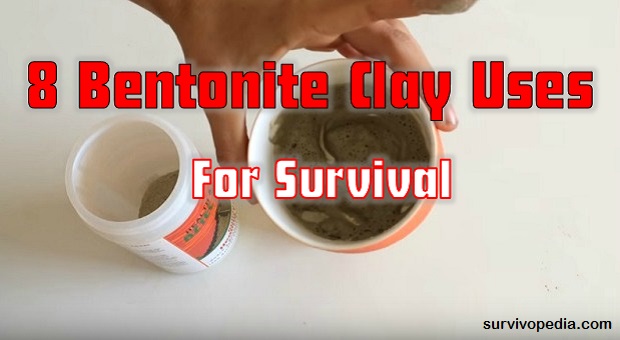
Bentonite clay has been used for centuries for everything from treating constipation to making toothpaste. There are so many practical uses for this versatile material that it’s a must-have for any prepper or homesteader.
Let’s talk about why this wonderfully useful clay should have a place in your survival planning or homesteading daily life.
Bentonite clay, also known as Montmorillonite, is composed largely of volcanic ash. It should be light grey or cream colored and should feel silky. If the clay that you get is white, it’s unlikely that it’s pure Bentonite. It’s also odorless and won’t stain your clothes, which is one reason why it’s used in so many different personal hygiene items.
There are two main types of Bentonite clay: Sodium Bentonite and Calcium Bentonite.
The primary difference is that Sodium Bentonite swells up to six times its size and has the most electromagnetic properties. It’s the one that you want to use for your face masks and external detoxifying.
Calcium Bentonite has smaller particles that don’t particularly swell like Sodium Bentonite particles do. This makes it better for ingestion because the smaller particles can pass through the colon and into the bloodstream. There, it does pretty much what Sodium Bentonite does; it attaches to the toxins in your body and leaves minerals behind.
1. Removing Impurities
Bentonite clay is named such because of the primary, huge deposit of the clay is located at Fort Benton, Wyoming. It’s unique in that it develops an electrical charge, a negative electric charge to be specific, when it’s wet.
This is important because toxins, heavy metals have a positive charge, so Bentonite clay can bond to them and carry them out of your body.
How? Bentonite swells and opens like a sponge when it comes into contact with water. The negative charge of the clay attracts the positive charge of heavy metals and other toxins and the toxin is absorbed into the clay and carried out of the body.
During this process, the minerals in the clay are also released into the body, so it’s taking the bad parts and leaving good.
2. Deodorant
First, bentonite clay can be used as an ingredient in your personal hygiene items. It may make your toothpaste or deodorant look a little more like mud than what you’re used to seeing, but because of its absorbent properties, it’s great to use as an antiperspirant.
Commercial deodorants are packed with chemicals that stop odor and prevent your pores from perspiring. These include aluminum, phthalates, talc, parabens, diethyl alcohol, and others.
To make deodorant, simply mix bentonite clay with equal parts baking soda (neutralizes odor), arrowroot or cornstarch (absorbs moisture), and a few drops of your favorite antibacterial essential oil.
Once you combine the powdered ingredients, add enough coconut oil to make it a smooth, thick paste, then add your food-grade essential oils. Remember that coconut oil liquefies at 74 degrees, so depending upon the temperature in your house, it may be the consistency of butter or it may be liquid. If you keep it in the fridge, it will be closer to the consistency of lard.
Video first seen on Steven Parente.
3. Face Masks
Many people also like to use it because of its ability to draw toxins out of the skin. This is one of the main reasons that it’s used in face masks. In addition to drawing toxins out with its negatively charged ions, the texture of the clay makes for a gentle exfoliant. This, along with the antibacterial properties of the clay, helps keep your skin free of blemishes.
Video first seen on Healthy Living on a Budget.
4. Wounds, Bites, Skin Ulcers, Eczema
A study conducted by Arizona State University shows that minerals in Bentonite clay have the potential to kill many antibiotic-resistant bacteria including MRSA, e.Coli, Staphylococcus aureus, and others.
It’s already been shown to effectively treat Buruli ulcers, and the only other treatment option is remove the lesion surgically and hope for the best. That’s saying something, even if it did take months of treatment with the clay to completely heal the wound.
To use it, for wound dressing or treatment of other conditions, make a poultice and apply it directly to the wound, changing it out when it dries. Remove the sting and itch of bites, burns, cuts, and scrapes by applying Bentonite clay and letting it dry.
Treat eczema in the same way daily. There are many different remedies for skin conditions that would meld well with bentonite clay.
For centuries, our ancestors survived using natural remedies to heal their wounds and other health problems. Click the banner below to discover more survival remedies for our forefathers!
5. Baby Powder
You’ve likely read about the link between talc and cancer. If not, check in to it, because it’s a big deal. Bentonite clay is a great option because it’s absorbent and has healing properties that may help prevent infections that love warm, moist environments.
6. Toothpaste
Bentonite clay is a great additive for your toothpowder because it may help brighten and re-mineralize your teeth. Some people also like to mix it up in water and use it as a mouthwash to kill oral bacteria than can cause tooth decay and bad breath. Simply add the clay to your standard tooth powder or toothpaste recipe.
Video first seen on Live Healthy and Blessed.
7. Morning Sickness and Nausea
Pregnant women who have tried taking 1/2 tsp. of Bentonite clay in a small glass of water to treat morning sickness have reported success in reducing nausea. Most doctors and midwives say this is fine, but check with you doctor before starting it, just in case.
People suffering from other digestive issues such as gas, bloating, and even parasites report positive results from simply drinking a 1/2 to 1 tsp. of Bentonite clay to water or juice daily.
Don’t use more than that, and drink a glass of plain water after you ingest the clay in order to keep the clay from settling in your stomach or digestive tract. Taking too much can also cause constipation.
8. Digestive Cleanses
Toxin buildups cause many symptoms including fatigue, allergies, headaches, skin conditions, and other conditions that apparently have no cause. Add a teaspoon of clay to your water, juice, or smoothie.
Though I couldn’t find any research supporting it (that’s pretty common with natural remedies because Big Pharma doesn’t want cheap, natural remedies to cut into their profits), it seems to me that if Bentonite clay removes heavy metals, it may be at least partially effective in removing radioactive substances. It certainly couldn’t hurt.
The most important things to remember about taking Bentonite clay are that need to follow it with plenty of fresh water so that it flushes through your system without settling, and that you shouldn’t take more than a teaspoonful a day.
Personally, I’m more interested in the external healing effects of the clay, but there are many who firmly believe in the benefits of taking it internally as well.
That decision is, of course, up to you.
This article has been written by Theresa Crouse for Survivopedia.
References:
https://www.ncbi.nlm.nih.gov/pmc/articles/PMC2413170/
2 total views, 2 views today
from Survivopedia
Don't forget to visit the store and pick up some gear at The COR Outfitters. How prepared are you for emergencies?
#SurvivalFirestarter #SurvivalBugOutBackpack #PrepperSurvivalPack #SHTFGear #SHTFBag


No comments:
Post a Comment